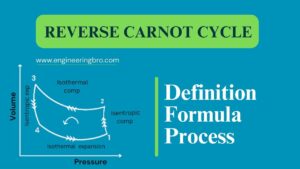What is the Reverse Carnot cycle?
The Reverse Carnot cycle is a type of thermodynamic cycle in which work is provided to transfer the heat from the “colder region to the hotter region” or from the “Hotter region to the colder region” and it is a reversible Cycle
For example:-
For the refrigerator/fridge, we provide an electric current(work) to reduce the temperature inside the fridge(that means we removed heat from inside the fridge and transferred it into the atmosphere)
Table of Contents
 |
| Reverse Carnot cycle |
what is the Reverse Carnot cycle in Refrigeration?
This cycle is a theoretical, ideal refrigeration cycle that achieves the maximum possible coefficient of performance (COP) During the cycle, a working substance absorbs heat from a cold reservoir, performs work on the substance, and then releases heat to a hot reservoir.
- The refrigerator that works on a ReverseCarnot cycle is called a “Carnot refrigerator”
In the context of a heat pump, The ReverseCarnot cycle is employed to transfer heat from a cold reservoir to a hot reservoir, which requires the input of work
- The heat pump that works on a Reverse Carnot Cycle is called a “Carnot Heat pump”
Note: Carnot Cycle works clockwise(work gain), ReversedCarnot cycle works anticlockwise(work supplied)
Reverse Carnot cycle process?
This cycle includes the following processes
Process 1–2: Isentropic Compression.
Process 2–3: Isothermal Compression.
Process 3–4: Isentropic Expansion.
Process 4–1: Isothermal Expansion.
Reverse Carnot cycle PV diagram?
The Carnot cycle includes the following processes
Process 1–2: Isothermal Expansion.
Process 2–3: Isentropic Expansion
Process 3–4: Isothermal Compression.
Process 4–1: Isentropic Compression.
Reverse Carnot cycle and Carnot cycle Difference?
Carnot Cycle | ReverseCarnot Cycle | |
Purpose | To convert heat energy into work (power cycle) | To transfer heat from a cold reservoir to a hot reservoir (heat pump cycle) |
Efficiency | Maximum efficiency for a heat engine | The maximum coefficient of performance for a heat pump |
Processes | Two isothermal and two adiabatic (isentropic) | Two isothermal and two adiabatic (isentropic) |
Operation Direction | Forward (from hot to cold) | Reverse (from cold to hot) |
Heat Transfer | Absorbs heat from a high-temperature reservoir | Absorbs heat from a low-temperature reservoir |
Work Output/Input | Work is produced by the system | Work is required as input to the system |
Efficiency Formula | η = 1 – Tc/Th (Th: hot temperature, Tc: cold temperature) | COP = Th / (Th – Tc) (Th: hot temperature, Tc: cold temperature) |
Reversibility | Reversible process | Reversible process |
Practicality | Idealized concept | Idealized concept |
Reverse carnot cycle pv and ts diagram

COP of Reverse Carnot cycle

Reverse Carnot cycle Applications?
Refrigeration Systems:
This cycle provides a theoretical framework for understanding the operation of refrigeration systems. It helps in analyzing and optimizing the performance of actual refrigeration cycles, such as vapor compression refrigeration systems commonly used in refrigerators, air conditioners, and heat pumps.
Heat Pumps:
This cycle is applicable to heat pump systems, which are designed to extract heat from a low-temperature source and deliver it to a high-temperature sink. Heat pumps are used for space heating, water heating, and industrial processes. While actual heat pump systems may operate on different cycles, the reverse Carnot cycle establishes the maximum achievable efficiency and performance benchmarks for such systems.
Efficiency Comparison:
The reverse Carnot cycle provides a reference point for comparing the efficiency of real-world refrigeration and heat pump systems. The Coefficient of Performance (COP) of a real system can be compared to the COP of the reverse Carnot cycle to assess its relative efficiency and identify areas for improvement.
Thermodynamic Analysis:
This cycle is often used in thermodynamic analyses and calculations as a standard of comparison. It helps in evaluating the performance of actual cycles, identifying sources of inefficiencies, and determining the maximum possible efficiency limits for given temperature differences.
Development and Research:
This cycle serves as a theoretical framework for researchers and engineers to develop advanced refrigeration and heat pump technologies. By understanding the fundamental principles and limitations of the cycle, innovative approaches and technologies can be explored to improve efficiency, reduce energy consumption, and minimize environmental impact.
While the Reversecarnot cycle itself is not practically achievable due to idealizations and assumptions, its principles and insights provide valuable guidance for the design, optimization, and analysis of practical refrigeration and heat pump systems
For more informative content read our other articles engineeringbro.com




